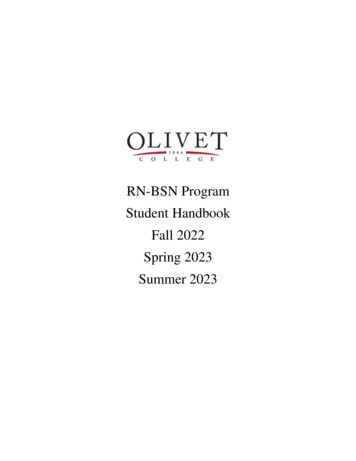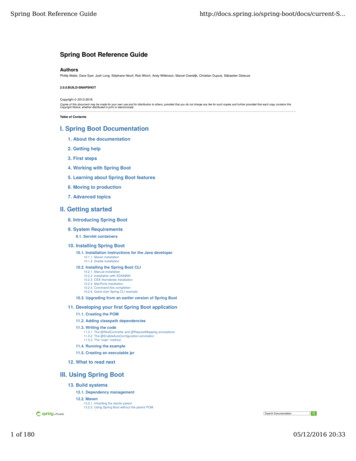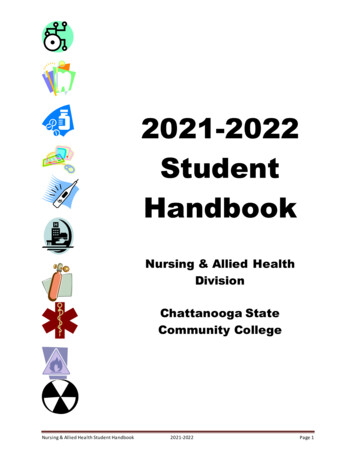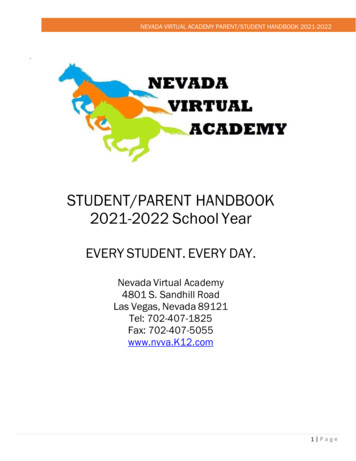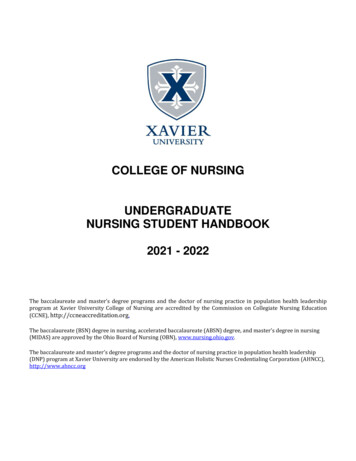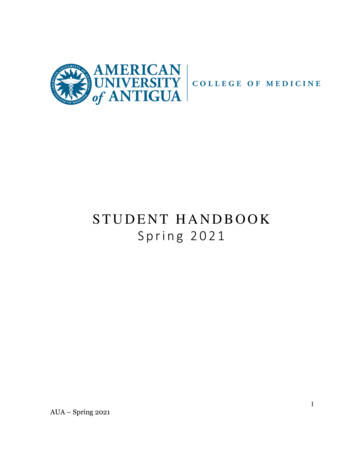
Transcription
STUDENT HANDBOOKSpring 20211AUA – Spring 2021
This Student Handbook is published by the American University ofAntigua (AUA) College of Medicine.The rules and regulations outlined herein are binding for and must be adhered to byall AUA College of Medicine students, including those on leave. The rules andregulations of this institution are reviewed and revised periodically. AUA reserves therights to revise, amend, and/or modify any of these rules and regulations and/or toadd or eliminate any rules and regulations at its sole discretion. Students will bebound by any change, amendment, revision, addition, or deletion of AUA rules andregulations and are expected to be familiar with the most recent revisions of theserules and regulations as well as all AUA manuals and publications, each of which canbe found on the AUA website. Although it is our intention to inform students inadvance of any changes to these rules and regulations, to AUA’s policies andprocedures, and/or to AUA’s curriculum and grading, AUA reserves the right to makesuch changes by publication in this Student Handbook. AUA also reserves the right tomake such changes prior to publication of any revisions of the Student Handbookwhen it is determined by the university to be in the best interests of ourstudents. Students will be notified when such changes take place through generalannouncements, in classes, on Blackboard, or by email.2AUA – Spring 2021
TABLE of CONTENTSINTRODUCTIONMessage from the President . 8Letter from the University Provost . 9Mission Statement . 11Contact Information . 11POLICIES & PROCEDURESEnrollment . 13Academic Degree Program . 13Standards for Admission, Promotion & Graduation . 13Institutional Learning Objectives . 15Curriculum Components and Courses .18Preclinical Science .18Clinical Sciences . 20Global Health Track . 21Degree Conferral . 25Registration . 26Family Educational Rights and Privacy Act (FERPA). 29Immigration: Entry to the U.S. . 31Tuition and Fees . 33University Refund Policy . 34Student Financial Services . 35Loan Program . 35Canadian Loan Program . 35Veteran Benefits . 36Return of U.S. Direct Loan Proceeds (R2T4) . 373AUA – Spring 2021
Academic Status . 39Good Standing . 39Satisfactory Academic Progress (SAP) . 39Introduction to Financial Aid Satisfactory Academic Progress Policies . 40Student Advising Program . 46Attendance . 48Preclinical Science (Years 1 & 2) . 48BSIC Intersession . 49Clinical Sciences . 49Absences & Leaves . 51Preclinical Sciences. 51Clinical Sciences . 52Withdrawals . 58Readmission . 60Examinations. 61General Examinations . 61Formative Examinations . 61CAS Examinations . 61Comprehensive NBME Examination (CBSE) . 62Objective Structured Clinical Examination (OSCE). 63Examination Policies . 65Grading of Exams . 66Exams in the Basic Science Integration Course (BSIC) . 69CBSE Off Campus (Post Antigua) . 69United States Medical Licensing Examination (USMLE) Step 1 . 70Clinical Sciences . 70Clinical Science Core Subject Shelf Exams . 70NBME Comprehensive Clinical Science Exam . 73USMLE Step 2 Clinical Knowledge Exam .754AUA – Spring 2021
USMLE Step 2 Clinical Skills Exam . 76Certification for USMLE Step 1 and Step 2 CK . 76USMLE Score Reporting . 78Testing Accommodations . 78Prometric Test Center Regulations .81Grading System . 84Course Grades . 84Clinical Grade Requirements . 85Transcripts. 86Clinical Clerkship Duty Hours Policy . 86Guidelines for Promotion and Dismissal . 89Guidelines for Promotion Year 1 . 89Guidelines for Promotion Year 2 . 89Clinical Sciences Criteria . 90Dismissals . 91Promotions Committee . 92Appeals Committee . 93Types of Appeals . 93Preclinical Sciences. 93Clinical Sciences . 94Medical Licensure in the United States . 95Educational Commission for Foreign Medical Graduates (ECFMG) . 95Application for USMLE Exams . 95ECFMG Certification . 96Residency. 96Student Conduct and Discipline . 98Professional Conduct and Ethical Behavior . 98University Ombudsperson . 995AUA – Spring 2021
Student Discipline, Disciplinary Hearings & Appeals . 101University Grievance Procedures . 108Policy of Non-discrimination . 113Policy on Peer to Peer File Sharing and Copyright Infringement . 114Acceptable Use of Technology . 116Classroom Communications . 117Residential Services . 118Student Health Clinic . 118Student Policy for Substance Abuse Prevention and Intervention . 122Library . 129AUA Approved Housing . 131Campus Transportation . 132Campus Parking Guidelines . 132Campus Recreation .138GENERAL & MISCELLANEOUS INFORMATIONHolidays and Weekends . 140Handicapped Access . 140Student Government Association (SGA) . 140Licensed AUA Medical Faculty. 140Health Insurance Policy . 140Basic Life Support/Advanced Cardiac Life Support Certification . 141Immunization Policy . 1456AUA – Spring 2021
INTRODUCTION7AUA – Spring 2021
MESSAGE from the PRESIDENTAmerican University of Antigua College of Medicine (AUA) was established byprominent American physicians and hospital administrators to provide qualifiedapplicants the opportunity to receive an American medical education.AUA’s medical education program is modeled on those of medical schools in the UnitedStates. Consistent with the new paradigm in US medical education, AUA studentscommence clinical exposure in the start of the first year at our hospital affiliate in St.John’s, Antigua.AUA is committed to offering a quality preclinical sciences medical education programthat provides students with experienced and capable faculty, small classes, and thelatest medical education technology.In addition to providing students with clinical opportunities at our hospital affiliate,AUA has established clinical rotations for its students at some of the finest teachinghospitals in the United States and has expanded its clinical reach to hospitals inCanada, India and Great Britain.It is AUA’s mission and my pledge as president to provide you with the best medicaleducation available and ensure that you receive the education you require to achieveyour goal of becoming a successful, well-respected, licensed physician.Neal S. SimonPresident, American University of Antigua College of Medicine8AUA – Spring 2021
LETTER from the UNIVERSITY PROVOSTDear Students,Welcome to our AUA Family. We are glad you are here. By now you have heard thatwe have a curriculum, called Curriculum Next.So what is this Curriculum Next all about? Our job on campus, is to provide you withthe necessary Knowledge, Skills and Attitudes to prepare you for your next phase ofmedical training; the Clinical Years. In addition, we must help you prepare for theUSMLE Licensing Examination Step 1, which you must pass to move on to that stageof your training. These are the issues that have compelled us to look carefully at ourcurriculum, and after reviewing the curriculum of the best medical schools in theU.S., put together Curriculum Next.Curriculum Next was developed using the latest in educational theory, and practice,supported by the most advanced technology, to assist you in developing the lifelonglearning skills required to be successful in the profession of medicine.During my over 35 years as a physician, there have been many changes in the way wepractice medicine. None have been more profound however, than the development ofteam based healthcare. Upon my entrance into the profession, most patient careoccurred with individual practitioners caring for individual patients. Now, patientsare cared for by healthcare teams typically led by a physician, or groups ofphysicians. Medicine has become a team sport. Consequently, being prepared towork and lead teams of healthcare professionals has become an essential skill formedical students, residents and physicians. This reality has changed the structure ofour curriculum.In Curriculum Next, you will be assigned to a Homeroom of twenty students and oneor two faculty facilitators. Your group of twenty will be further divided into smallgroups of ten. A moveable wall will separate the groups and the majority of yourlearning will occur within these small groups. Students will also be divided intoColleges. This will be the cohort that will work in large group learning sessions suchas Lecture and Team Based Learning, and participate in collegial rivalries. Thecurriculum is standardized by the use of the same learning objectives for all groups.Students will take the same examinations, as well as receive both individual andgroup feedback. While there will be considerable facilitator direction in MED 1,student directed learning is expected to increase and dominate the process as youmove further in your education.This team based learning process necessarily requires a different perspective thanperhaps you are used to. During your medical training and practice, you will not beable to choose your attending physicians, resident supervisors, or medical student9AUA – Spring 2021
teammates. You will be assigned to patient care teams throughout your educationalexperience. This will begin here on campus, in that you will be assigned to aHomeroom and small group and your facilitators will be assigned as well. The groupswill remain intact for the entire MED 1 term. In MED 2, group assignments will againbe made randomly. Requests to change groups will not be entertained.Small group learning will require some different expectations regarding yourbehavior as well.Attendance: Your physical, intellectual, and emotional presence is required 100%of the time (see attendance requirements for details). This is especially importantas the group will be relying on you to be present to function properly.Preparedness: For similar reasons, the group will be relying on you beingprepared for class. Preparation no longer only affects you; it now affects theentire group.Cooperation and compromise: When working within a group these are importantcriteria for success.While these requirements may seem challenging to you now, the academic leadershipof AUACOM is experienced in this approach to teaching and is confident that you willfind it both satisfying and useful over time.As a graduate of the first class in a new medical school (USCSOM 1981), I canappreciate the anxiety that being part of something new and groundbreaking canbring. That said, it is also exhilarating, and satisfying. I hope you will agree.Welcome again, to our AUA family.Robert Mallin, MDUniversity Provost10AUA – Spring 2021
MISSION STATEMENTAmerican University of Antigua (AUA) College of Medicine is an innovative medicalschool dedicated to providing a learner-centric education of the highest quality,granting opportunities to underrepresented minorities, fostering a diverse academiccommunity, and ensuring that its graduates develop the skills and attitudes oflifelong learning, compassion, and professionalism. We also provide students whowould otherwise be unable to receive a medical education with the tools to becomesuccessful physicians.AUA was founded with the commitment to support underserved communities andaddress the impending physician shortage with an emphasis on primary care. Assuch, the university recognizes its social responsibility to advance the field ofmedicine and lead the next generation of physicians and health-care professionals torespond to global health-care needs.CONTACT INFORMATIONMANIPAL EDUCATION AMERICAS—REPRESENTATIVE FORAMERICAN UNIVERSITY OF ANTIGUAAddress:Telephone:Fax:Email:Website:40 Wall Street, 10th FloorNew York, NY 10005212-661-8899; med.orgwww.auamed.orgADMINISTRATIVE OFFICE IN ANTIGUAAddress:Telephone:Fax:Email:Website:Main Campus, University ParkP.O. Box W1451, Jabberwock Beach RoadCoolidge, St. John’s, Antigua, .netwww.auamed.org11AUA – Spring 2021
POLICIES &PROCEDURES12AUA – Spring 2021
ENROLLMENTACADEMIC DEGREE PROGRAMThe Doctor of Medicine degree is conferred upon students who satisfactorilycomplete the following requirements:1. Preclinical Sciences: Two 19 week periods in Year One; Two 19 week periods inYear Two2. BSIC Intersession: 13 weeks of Basic Sciences Integration Course, mandatoryNational Board of Medical Examiners (NBME) Comprehensive Basic ScienceExamination3. Clinical Sciences: 84 weeks of clinical core and elective rotations (including theFamily Medicine I/Internal Medicine I-Advanced Introduction to ClinicalMedicine (The duration is 6 weeks for students who attended a 2-week clinicalskills course on campus and 8 weeks for students who did not attend thatcourse)) over four semesters (Semesters Five through Eight)4. United States Medical Licensing Examination (USMLE) Steps 1 and 2 (CK andCS*)*Based on the 12 to 18 month suspension of Step 2 CS by USMLE, AUA has decidedto suspend passing of USMLE Step 2 CS as a requirement for graduation as well as allcomponents of the Clinical Skills preparation program with immediate effect.STANDARDS FOR ADMISSION, PROMOTION, AND GRADUATION INTHE DOCTOR OF MEDICINE (MD) PROGRAMThe goal of every competent physician is the delivery of quality patient care, ascharacterized by the capacity to acquire and use diverse and complex knowledge;apply relevant psychomotor and communication skills; exercise clinical judgment anddecision-making based on evidence; and critically evaluate both patient outcomesand personal clinical performance. Applicants must be capable of functioning in highintensity, stressful environments both academic and clinical. To these ends,applicants must be capable of meeting the physical, psychosocial, and emotionaldemands of an academic medical curriculum in anticipation of encountering similardemands in the practice of medicine.The standards required include the following:13AUA – Spring 2021
Visual Students must be capable of acquiring academic information from diverse media(e.g., print, digital, graphic imaging, and video).Students must be capable of using the clinical tools of the profession (e.g.,microscopes, sphygmomanometers, EKGs, products of digital imaging and othervisually oriented diagnostic procedures, and tests).Oral and Auditory The language of instruction is English. Students must be fluent in English.Students must be capable of effectively interacting with patients, faculty, andhealth-care staff in a sensitive and timely manner. Students must be capable ofeffectively communicating the findings of an examination to patients and, asrequired, to other members of the health-care team.Students must be able to use the techniques of the profession in conducting aphysical examination (e.g., auscultation, palpation, and percussion).Motor Strength and Mobility Students must possess the precision (fine motor skills), strength, and stamina(gross motor function) necessary to conduct common diagnostic procedures (e.g.,sigmoidoscopy) and physical interventions (e.g., CPR, surgery, intubation,establishing central lines, and IVs) commonly used in the profession.Students must be capable of participating actively in classroom, laboratory, andclinical settings over extended periods of time.Sensory Students must possess tactile and olfactory abilities appropriate for the care ofpatients (e.g., palpation).Cognitive Students must be capable of self-directed, self-motivated learning andinformation gathering.Students must be capable of assimilating, analyzing, and synthesizing informationin a timely fashion for use in solving clinical problems.Students must be capable of analyzing, interpreting, and reasoning in a timelyfashion for the purpose of solving clinical problems.14AUA – Spring 2021
In interactions with patients and colleagues, students are expected to exercisegood judgment and common sense consistent with the ethical expectations of themedical profession.Social Students must possess the perseverance, diligence, and consistency necessary tocomplete the medical curriculum and enter independent practice of medicine.Students are expected to be capable of receiving and responding appropriately tofeedback, both positive and negative.Students are expected to have the social skills to interact effectively with patientsand colleagues.Students are expected to possess cultural sensitivity that is respectful of eachpatient’s and each colleague’s race, religious beliefs, ethnicity, national origin,creed, color, age, marital status, sexual orientation, gender preference, and otherpersonal characteristics.Students are expected to be capable of establishing sensitive, professionalrelationships with patients.Students are expected to learn, grow, and become effective members of thehealth-care team.INSTITUTIONAL LEARNING OBJECTIVESCompetenciesMedical Knowledge: Students must demonstrate knowledge ofestablished and evolving biomedical, clinical, epidemiological, social, andbehavioral sciences, as well as the application of this knowledge topatient care.Describe the normal structure and function (morphology and physiology) of thehuman body and each of its major organ systems across the life span.Describe how molecular, biochemical, cellular, and genetic mechanisms affect humandevelopment and maintain the body’s homeostasis across the life span.Describe the scientific principles underlying diagnostic methods, including laboratoryand radiologic testing and treatment approaches (pharmacologic and nonpharmacologic) that may be applied to major diseases and conditions.Demonstrate knowledge of physical and functional principles of normal and alteredhuman behavior throughout the life cycle, including scientific basis for diagnostic andtreatment approaches applied to these conditions.15AUA – Spring 2021
Explain how social determinants, health behaviors, and preventive measures affectdisease, illness, and health in individuals and across populations regionally,nationally, and globally.Demonstrate knowledge of the scientific method in establishing causation of healthand disease, the utility of diagnostic modalities, and the efficacy of therapies(traditional and nontraditional), through critical evaluations of current preclinicaland clinical scientific knowledge.Patient Care: Students must be able to provide patient care that iscompassionate, appropriate, and effective for the treatment of healthproblems and the promotion of health.Obtain essential, accurate, and age-appropriate information about patients.Formulate an accurate and comprehensive differential diagnosis that synthesizesrelevant patient data.Develop an appropriate evaluation and management plan utilizing patientinformation and preferences, evidence-based medicine, and clinical judgment.Provide care that is responsive to the personhood of the patient, inclusive of culture,ethnicity, spirituality, gender, age, disability, and other aspects of personal and/orhealth beliefs, practices, and decisions.Counsel and educate patients appropriately using accurate, up-to-date information.Partner with patients to prevent health problems and improve health status.Perform routine procedures safely and correctly with appropriate supervision.Work as members of interprofessional health-care teams to provide effective, safe,quality, and patient-focused care.Interpersonal and Communication Skills: Students must demonstrateinterpersonal and communication skills that facilitate effectiveinteractions with patients, their families, and other health professionals.Communicate effectively with patients, patients’ families, colleagues, and otherhealth-care professionals through the use of active listening and appropriate verbal,nonverbal, and written skills.Foster therapeutic and ethically sound relationships with patients through respect,empathy, and by providing emotional support.Demonstrate effective collaboration skills as a member of a team, including learningteams and health-care teams.16AUA – Spring 2021
Professionalism: Students must demonstrate a commitment toprofessional and personal excellence in all settings, including adherenceto ethical principles and sensitivity to a diverse patient population.Demon
Address: 40 Wall Street, 10th Floor New York, NY 10005 Telephone: 212-661-8899; 1-888-AUA-UMED (1-888-282-8633) Fax: 212-661-8864 Email: info@auamed.org Website: www.auamed.org ADMINISTRATIVE OFFICE IN ANTIGUA Address: Main Campus, University Park P.O. Box W1451, Jabberwock Beach Road






